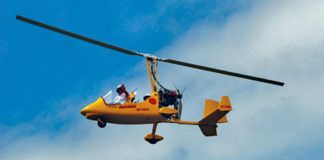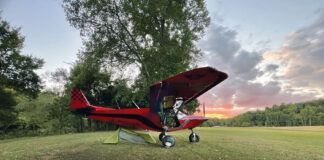KITPLANES Magazine, March 2002
We build a set of floats from our vacuum-bagged molds. Part 2
By Cresswell Walker
In Part 1 of this series, we created a set of vacuum-bagged molds that could then be used to build a set of ultralight floats. This time, we’ll build the floats from these molds using vinylester and fiberglass composite materials. After many hours of constructing the plug and the molds for the float skins and bulkheads, we were keen to get started and couldn’t wait to begin experimenting.
Selecting Composite Materials
Composite construction offers many choices in material combinations, so first we had to make some key decisions about what we were going to use in our newly minted molds. That is one of the great things about composite construction: Once the molds are done, it is relatively easy to experiment with different combinations of materials to create parts with varying strength, stiffness and weight characteristics. Perhaps the most important decision for our float project, despite its higher cost, was to select epoxy vinylester resins over polyester resins. For the demands of aircraft floats, traditional polyester resin just doesn’t cut it.
Epoxy vinylesters are well-known for their strength and durability in aviation and in specialty marine applications. They have high cohesive strength, and they wet out and bond well to glass fiber. These resins are tough because of their high tensile-elongation strengths. They also resist water permeation and abrasion, are lightweight, and have outstanding fatigue resistance. They process easily with catalyst systems and have low toxicity. Vinylester saved weight and facilitated a float design with the structural capacity to flex and absorb some of the stresses of rough-water takeoffs and landings.
For reinforcement material, we chose conventional glass fibers. Fiberglass has the best physical characteristics at the lowest price. Most of the float structure was laid up in two and three layers of 18-ounce/square yard roving with a spun-glass-core mat in areas requiring additional panel stiffening. We could have shaved a few more pounds off of each float by using Kevlar or even carbon fiber, but this would have nearly doubled the cost. Besides, at 25 pounds per float, we were already well ahead in the weight game.
Float Skins Layup Preparation
Preparation for layup of the six shells or skins needed to build two floats began with measuring and cutting 3mm poly patterns of each piece of material to go in the molds. This required some planning to determine how many layers of what weight and type of fiberglass roving and coring would go where in the float. To create the optimum weight/strength relationship, more material was placed in the higher stress sections in the float center, and less was placed in the ends. The patterns sped the cutting process, minimized waste and kept the materials in both floats the same size, shape and weight.
After all of the fiberglass material was cut, it was weighed and set aside. This weight was used later to determine the amount of resin to be added to the mold during the actual layup.
Gelcoat
Now, at last, it was time to start building. We prepared the mold and mold flange surfaces with Zyvax mold-release agent and started spraying on the creamy clamshell white vinylester gelcoat. Gelcoat was kept to a minimum to conserve weight; we sprayed on a little less than a liter of vinylester gelcoat per float. This proved to be just enough thickness to minimize print through of the fiberglass roving while resulting in the very clean, high-gloss finish that characterizes composite parts.
Vacuum Bagging
In 3 or 4 hours, the gelcoat had cured to a tacky state sufficient to start laying up the fiberglass. With today’s rapid-curing resins, a continuous build cycle with all layup completed before any layer reaches an advanced cured state ensures better interlayer adhesion, a more precise resin/cloth ratio, and the greatest overall strength.
With vacuum bagging, all layup occurs as wet on wet in a one-step process. All layers of woven roving and core mat are placed in position in the molds on top of the tacky gelcoat. The vacuum-bagging film is stretched over the mold and is sealed in place with a surgical-hose gasket and butyl tape. Then the vacuum is turned on to pre-compress the fabric. This also gave us a chance to track down a few air leaks that inevitably seem to be a part of the process. We taped these over with another secret weapon: clear packing tape.
As a working minimum, the mold should be sealed sufficiently to maintain a vacuum of 25-27 inches of mercury or about 10 psi. When placing the bagging film, it is essential to tuck sufficient film into the mold so that the film can be pulled and pressed fully into the edges and corners. If bridging occurs as a result of the film being a little too tight around a corner or seam, the resin will often not sufficiently wet the fiberglass deep in the corner. This may result in a weak spot and the risk of the gelcoat breaking away later. Getting enough bagging film into the mold to reach all of the corners, but not so much that there are too many wrinkles in the film, takes practice. It’s an art.
Resin-to-Glass Ratio
When we were satisfied with the vacuum film position and the mold seal, we turned off the vacuum, lifted a corner of the film and poured in enough resin to achieve our 40:60 ratio of resin/glass. With the resin in the mold, the film was resealed, and a partial vacuum was applied. We began to squeegee the resin through the fiberglass in the mold. Once all of the cloth was wet, total vacuum was applied, and the final squeegeeing took place.
The resin was worked out of the center of the mold and up and onto the flanges beyond the part area. The trick is to wring out just enough resin to achieve total glass wet-out without starving the fiberglass. Achieving the exact ratio is a matter of experience with the mold and materials. With vacuum bagging, it is possible to over squeegee and end up with an overly lean layup. In this aspect, our experience in the shop was especially valuable.
With bagging, it is also possible to achieve a very clean inside part surface. The bagging film can be pulled smooth on the surface of the part by gathering excess film into darts. The vacuum film, pressing onto the surface during the cure, creates a smooth and shiny or mat inside surface that is tack free. (Non-waxed resin will not dry tack free unless it cures in an environment that is oxygen free.)
You can achieve an even more uniform surface with peel ply, which is a polyester or nylon cloth material placed in the layup as the last layer. Peel ply does not adhere to the layup, thus allowing it to be peeled off after the layup has cured. It provides an added benefit of absorbing excess resin from the composite skins. The application of peel ply is especially important if you are going to complete another layup sometime after full cure. After about an hour per mold of layup, adding resin and squeegeeing, the parts were left to cure overnight.
The next morning I was excited about pulling the first of the skins out of the molds. They were, shall we say, a qualified success. The vacuum film layup had been less than perfect. There was bridging over some corners, some dry spots where the cloth was not adequately wet, and poor adhesion to the gelcoat. We were schooled on the first set and produced a much better set the second round. As is typical with new molds, we found the quality improved with each layup.
Putting It All Together
Putting the skins together with bulkheads and attachment points went quickly and easily. The first step was to butt-join the two side/bottom skins along the bottom center seam. We used the flashing to align and hold the bottoms together until we filled and bonded the seam with a pre-mixed resin/chopped glass product called Dynaglass. This was reinforced with two hand-laid layers of tri-axial mat/roving on the inside of the float. Then we turned the joined halves upside down, ground off the flashing and finished the seam with brushed-on gelcoat.
Next the bulkheads were bonded in place in the hull with high-strength bonding silicon. This also created the internal watertight compartments. Aluminum backup plates were bedded into the transom for the rudder attachment fittings. Before installing the top, we built in the four attachment hard points. These were made by bedding lengths of 1-inch-inside-diameter fiberglass tubing in Dynaglass and covering them with tri-axial roving in a one-step layup. A hole was drilled into the fiberglass tube end to take the spreader bars. The top of each of these hard points was drilled through to take the deck attachment brackets. The hard points were aligned with the main bulkheads to distribute the loads to the float hull.
The last step was to epoxy the top onto the joined bottom halves. The top was dry-fitted onto the bottom, and holes were predrilled for the temporary screws that would be used to hold the top in position while the epoxy cured. We masked along the seam and then applied a liberal mix of E.A.S.T. system epoxy and chopped fiber filler to the shoebox join and over the bulkhead tops and sides. It was a two-person job to put the top in place and set the screws (once we figured out which top went on which bottom).
After the epoxy had cured, the seam was filled and faired with Dynaglass. We could have finished the seam with gelcoat and sanded and polished it to create an invisible seam, but instead we simply finished it with auto pinstripe tape. Call me lazy, but the red stripe made the floats looks pretty snazzy. For a temporary nose bumper, we shaped and painted a small piece of foam and bonded it in place with silicon.
After several months of going back and forth to the shop, it was with great anticipation that we stood on the shore of Kootenay Lake and watched Don Usher prepare to test-fly this first set of composite floats on his miniMAX. Usher had been flying for two seasons on a set of wood floats he built from my plans, so I was very interested in his assessment of the composite version. The composite floats were noticeably lighter, so he had better in-flight performance. I had hoped for his takeoffs to be even faster, but they were pretty much as they were on the wood floats. At 8 seconds, what the heck is the rush?
The new floats are nearly impervious to water, and we think they will prove to be more durable on the beach with rough use. And there is something about the glassy finish of composite parts…
My limited experience with composite construction has impressed me with how flexible a construction method it is, especially with so many modern materials available. Although it takes some experimenting to get just the right combination of materials to match the strength-to-weight requirements of each part, the high-quality end product is worth the effort. If you have been interested but hesitant about trying a composite project, my advice is: “Come on in. The water’s fine.”
For More Information, contact the author at 250/755-4003; e-mail [email protected] or visit the web site at http://www.ultralightfloats.com/.





